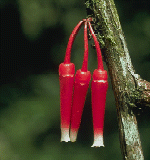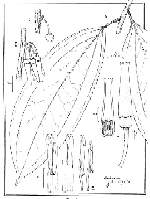References: LUTEYN, J. L., New species and notes on neotropical Ericaceae. Opera Bot. 92: 109--130 (1987).


Epiphytic or terrestrial shrubs. Leaves alternate, evergreen, coriaceous, usually plinerved but rarely pinnately nerved, petiolate. Inflorescence axillary, pin-cushion type (glomerulate), racemose, or subfasciculate, often ramiflorous, with few to many, often pendent flowers. Flowers 5-merous, without odor; aestivation valvate; calyx articulate with the pedicel; hypanthium subglobose to shortly campanulate; limb flaring or spreading; lobes (3--4) 5, ovate to triangular or merely apiculate; corolla cylindric to narrowly vasiform, carnose, the lobes triangular to narrowly oblong, acute; stamen 10, of alternately unequal lengths, usually about 1/3 as long as the corolla; filaments equal and firmly connate into a tube for more than half their length, membranous to thinly coriaceous, lacking spurs; anthers basifixed, firm, alternately unequal in length, slightly dimorphic in shape, the longer ones spreading distally with the tips then often incurved and often ornately decorated in a dendritic pattern and the tubules twisted to present latrorse dehiscence, the shorter ones laterally coherent distally with the tips straight and often not ornate and the tubules straight to present introrse dehiscence, lacking disintegration tissue; thecae subcoriaceous, slightly to not granular; tubules not sharply differentiated from the thecae, dehiscing by subapical pores; pollen without viscin threads; ovary inferior; stigma usually truncate; style filiform and as long as the corolla or slightly exserted; nectariferous disc usually conspicuous, annular-pulvinate. Fruit a spherical berry, dark blue-black, rarely translucent white.
Satyria
is a well marked but taxonomically difficult genus of approximately 25 species, inhabiting
tropical lowland rainforest to montane cloud forest and ranging from southern Mexico
to Bolivia and east to French Guiana.